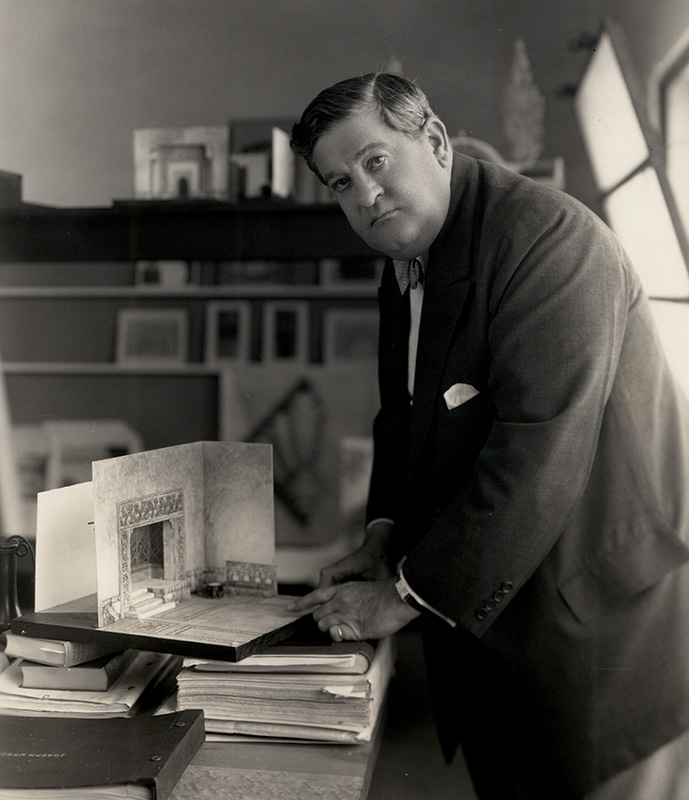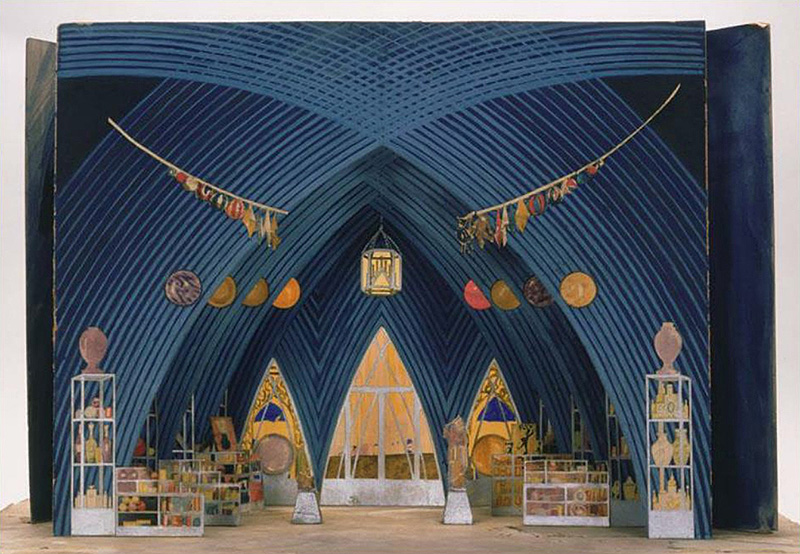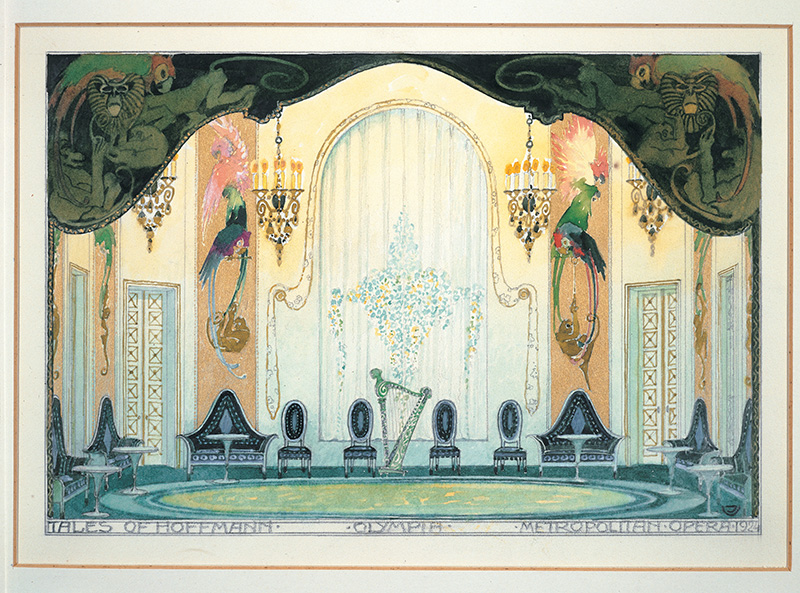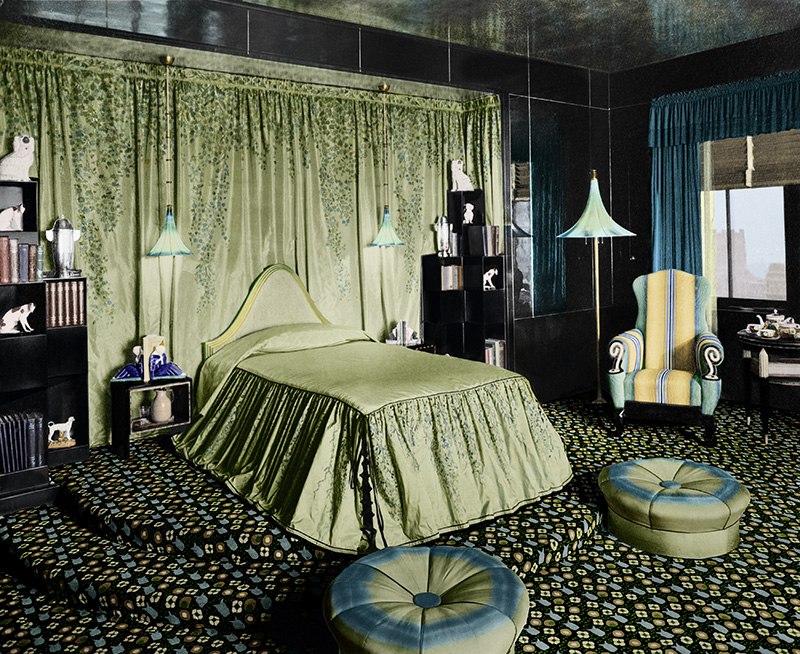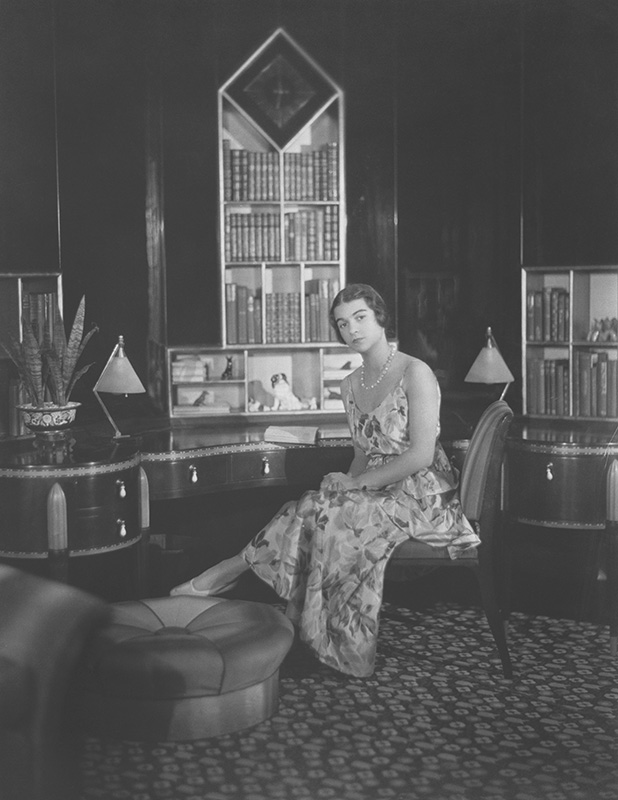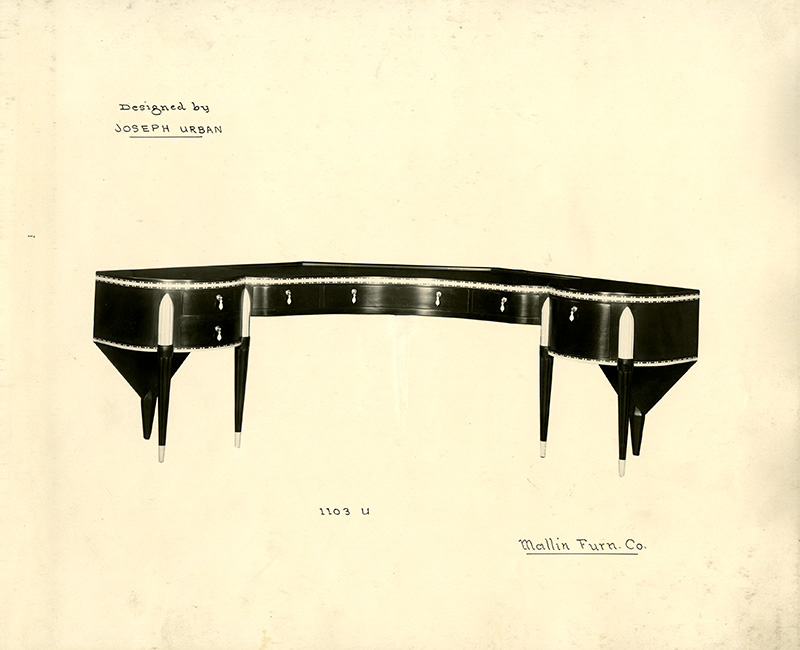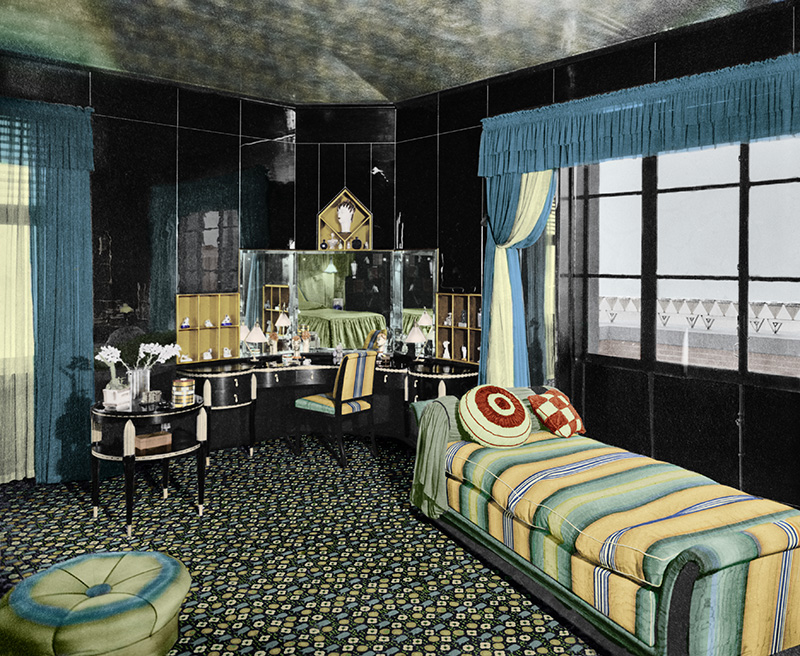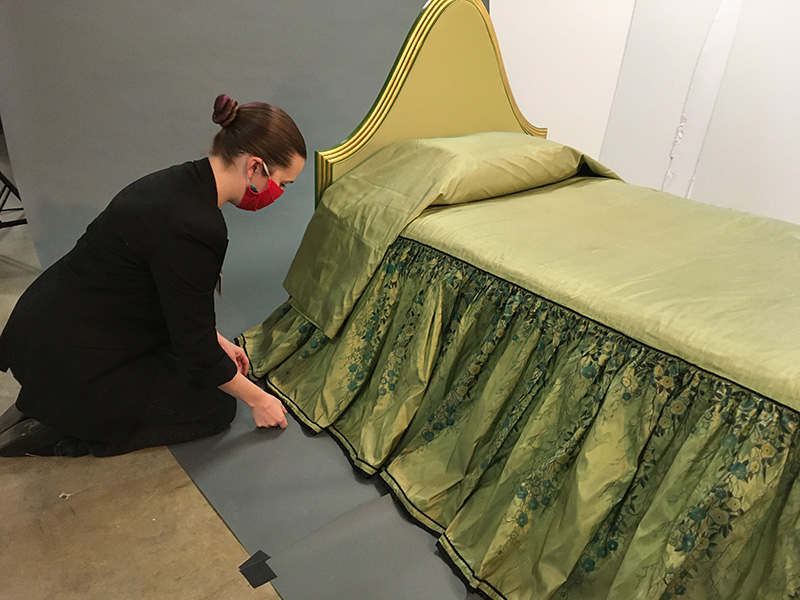Factory of Illusions: Researching and Reconstructing an Art Deco Bedroom by Joseph Urban
by Talia Shiroma
In 1912, 15 miles north of Boston, enshrouded by apple trees and workers’ housing, lay the studio of the Boston Opera Company, whose modest appearance belied the colorful activity of its interior. Before a new stage production, the opera’s Austrian-born art director Joseph Urban (figure 1) would descend upon the studio to deliver intricate sketches of stage sets and confer with the artists and craftspeople who brought his designs to life. From Urban’s colored sketches grew delicate cardboard models of each act, at 1/25 scale, painstakingly painted and illuminated with colored lighting by two Viennese artists (figures 1, 2, and 3). After perfecting the models, scene painters raced across fields of canvas spread on the ground to create the stage’s backdrops, wielding enormous paintbrushes and oversized palettes mounted on four wheels. Carpenters and other craftspeople constructed props from wood and papier-mâché, and a sewing department led by two Austrian women hand-stitched swathes of gauzy netting, drapery, and clusters of artificial flowers. A newspaper article in The Boston Evening Transcript, marveling at the artistic effects produced by the studio, pronounced it the “factory of illusions.”
Joseph Urban gained fame through the 1920s for his inventive, modernist designs across a wide spectrum of media, including theater and film sets, architecture and interiors, and industrial products. Like his contemporaries in Europe and America, he relied on the expertise and labor of craftspeople and other collaborators to realize his ideas. Chief among them were the artists in the Boston Opera Company workshop, who had worked with Urban back in Vienna and eventually relocated to the designer’s private studio in Yonkers, NY. Along with his atelier, Urban partnered with furniture manufacturers and many other specialists to fabricate the decorations that adorned his clients’ clubs, restaurants, and homes.
This summer, the Cincinnati Art Museum displays an exhibition based on Urban’s late-1920s commission for Leo F. and Helen Wormser of Chicago. Over several years of researching and reconstructing this work of art, a bedroom for their daughter Elaine (figures 4, 5, and 7), the curatorial team, led by Amy Dehan, gleaned information about the workers and manufacturers who potentially fabricated many of the room’s design elements, as well as the domestic workers who maintained the interior. This research, in addition to information that situates the bedroom, its designer, and its occupants in the social and artistic milieu of their time, will be available to visitors on the interactive website for the exhibition.
I was brought onto the Urban project as an intern during the summer of 2021 to assist with researching and writing content for the interactive element, whose development was generously supported by the Decorative Arts Trust. Designed as both an in-gallery resource for visitors and an electronic version of the exhibition that will live on after the physical presentation’s closure, the interactive website presented the opportunity to elaborate upon the room, its afterlife, and its reconstruction in a portable and more expansive digital space beyond the gallery. The interactive also permitted us to incorporate material into the exhibition that enlivened objects in the bedroom or expressed the diversity of Urban’s artistic production, but would otherwise be challenging to borrow or display in the gallery—such as Urban’s set models, clips from films for which he produced designs, archival documents, and audio snippets from interviews with Elaine Wormser, the young woman for whom the bedroom was commissioned.
Finally, panoramic imagery of the reassembled Wormser bedroom on the interactive will allow the room—consisting of the most complete collection of objects from an Urban interior known to exist—to remain accessible to the public past de-installation. This preservation of the room, albeit virtual, stands in contrast to the loss of many modernist interiors, including nearly all of those designed by Urban.
As I developed content for the interactive, I became interested in further researching the subject of the workers who produced the original bedroom as an opportunity to pay tribute to the hidden labor behind many of the objects, as well as to reflect on the relationship between Urban and the skilled collaborators who produced his designs. We know that Urban routinely consulted with his studio on details such as cost and material, and he solicited the advice of at least one furniture manufacturer on how to produce modernist furnishings more palatable to American consumers. For the Wormser commission, he likely worked with a manufacturer called Mallin Furniture Company, whose name appears in portfolio pages located in Urban’s archives that depict furniture from the bedroom, such as the desk in figure 6 (shown in situ in figures 5 and 7). As I wrote content for the exhibition’s digital interactive, I was able to delve into the stories of the company’s immigrant founder, Morris Charles Mallin, the speculative lives of the 14 furniture workers he employed, and more broadly, the industrial workers who toiled in hazardous conditions to produce many of the modern materials Urban used in the bedroom. Although the historical record has not been kind to these workers and collaborators, whose identities and contributions are largely unrecorded, their practical knowledge and skills were central to Urban’s designs, enabling him to create an extraordinarily vast and diverse set of works that incorporated innovative materials and techniques.
Once construction of the Wormser bedroom in the family’s Drake Tower penthouse reached fruition, another set of workers would have maintained the room’s appearance. Census records show that in 1930, the year the bedroom was completed, the Wormsers employed three immigrant household workers—Ina Alam, Edith Thulim, and Amelia Thoridl—who cooked and cleaned for the family. A floorplan of the Wormsers’ apartment depicts the three small rooms where they resided, and the nearby kitchen where they likely spent their downtime. Not surprisingly, we were unable to find documentation of these women’s lives beyond the 1930 census. Instead, I attempted to flesh out their circumstances through research into the lives of household workers in the early-20th century, as well as the changing nature of U.S. domestic service more broadly in the 1920s as it intersected with race, gender, migration, and advancement in household technologies.
This research opened another perspective on the bedroom for me: not only who it was designed for, but speculatively, who it was used by. Besides Elaine Wormser, the household workers likely had the most frequent contact with the room. Many of the modern, industrially produced materials that Urban used in the bedroom were attractive not only for their novel associations with technological progress and their ability to simulate more expensive surfaces, but also the supposed facility with which they were cleaned. Perhaps Ina, Edith, and Amelia appreciated the relative ease of wiping down Elaine’s desk, or they resented the smudges that irrepressibly appeared on the sleek black Vitrolite walls of the bedroom. The visual effects Urban intended for the bedroom, fresh and lustrous with its profusion of reflective surfaces, would have needed continual upkeep: the labor of cleaning, then, may form an equally important part of the interior’s presentation.
Paralleling the work that went into the original bedroom, the skill and expertise of contemporary craftspeople and the museum’s preparators and conservators will also be on display in the exhibition. Textile designers and weavers, furniture makers, and lamp fabricators created reproductions of essential elements of the bedroom that were damaged or missing from the museum’s collection. Conservators repaired and stabilized objects, while preparators advised on reproduction techniques and installed the bedroom. Reflecting the intricacy of the room’s reconstruction, the interactive includes a “behind the scenes” portion that introduces visitors to the research, conservation, and reproduction work that enabled the bedroom’s display (figure 8). Perhaps the most valuable insight I gained throughout my internship was the sheer scale of cooperation and specialized labor necessary to mount an exhibition—how the museum’s own “factory of illusions” is operated and animated by many hidden hands.
Information about the individuals behind the original bedroom, as well as careful documentation of the work involved in the complex, years-long process of its reconstruction, will be published on the Joseph Urban interactive website, easily accessible at cincinnatiartmuseum.org beginning in July. I am excited for visitors to discover, as I have, the fascinating story of this interior and its afterlife. Unlocking an Art Deco Bedroom by Joseph Urban runs at the Cincinnati Art Museum from July 8 to October 2, 2022.
Talia Shiroma served as the Joseph Urban Interactive Interpretive Intern at the Cincinnati Art Museum in 2021. She is currently Curatorial Assistant, Arts of the Americas and Europe, at the Brooklyn Museum.
A print version of this article was published in The Magazine of the Decorative Arts Trust, one of our most popular member benefits. Join today!

